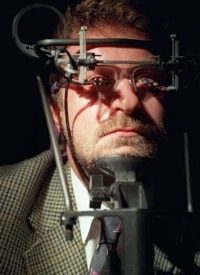
The UNC study appeared to be aimed at establishing medical validation of schizophrenia, as opposed to a hodge-podge of subjective symptoms. If a physical finding were to prove both confirmable and replicable, the study might have strengthened the cause du jour — “biological psychiatry,” a controversy in itself. Indeed, the ongoing search for a biologically based component in mental afflictions has continued unabated. Driving it is an agenda aimed at mass screening, ostensibly for early-detection and treatment purposes, to be administrated by government.
Proponents understandably seek legitimacy for psychological phenomena — schizophrenia, paranoia, ADD, obsessive-compulsive disorder, depression, etc. They want mental afflictions placed on a par with diabetes (elevated blood sugar levels), PKU (a missing or decreased enzyme called phenylalanine hydroxylase), multiple sclerosis (damage to the protective covering that surrounds nerve cells) and other devastating illnesses that carry clear, physical abnormalities and/or chemical “markers” which, while not curable, are nevertheless treatable, raising the quality-of-life for sufferers if detected early.
Dr. Fred A. Baughman is a retired California pediatric neurologist who frequently is called upon to testify before state legislatures and national boards. He both discovered and described such medical anomalies as curly hair-ankyloblepharon (fused eyelids), nail dysplasia (called CHANDS or Baughman’s syndrome/disease), the glioma-polyposis syndrome, and the association between essential tremor and sex-chromosome abnormalities. So, he knows a thing or two about the scientific method. To clarify the meanings of “disease” and “abnormality,” he says:
A disease is a physical abnormality — a “gross” (e.g., rash visible to naked eye, tumor felt through skin or by palpating belly or breast), “microscopic” (e.g., pap smear from cervix, detection of malignant cells in blood as in leukemia, and … chromosome abnormalities), or “chemical” (e.g., missing enzymes, heightened blood sugar levels, and other of some 100-200 inborn errors in such afflictions as PKU, diabetes, uremia, maple sugar urine disease). If no abnormality is found in the diagnosis, the patient is disease-free; in medical terms, there is no evidence of disease (NED) or no organic disease (NOD). No patient with a psychiatric diagnosis alone has a physical abnormality, disease or disorder.
Mental health activists point to recent cultural pathologies such as the uptick in teen suicides and mass murders of the Columbine and Virginia Tech variety to bolster their case for a committed, government-sanctioned program of universal psychiatric screening and early “interventions,” which can mean anything from drugs and psychotherapy to random home visitations by mental health workers (to be covered further in Part III).
As psychiatry expands its reach, it threatens to create conditions where every person’s thoughts and behavior seem ripe for vetting by an “expert.”
Thus do universities, foundations, hospital consortiums and government agencies at the local, state and federal levels vie for grants — taxpayer-funded and private — aimed at finding and treating the elusive causes of bizarre behaviors and unwanted thoughts.
The larger problem, though, remains medicalization of “thought disorders” and behavioral phenomena — because successful medicalization means legitimacy in the media, and legitimacy “sells.” It sells pills; therapists; research grants; and new screening instruments for use in schools, job interviews and the workplace.
When psychiatry split from neurology back in 1948, Dr. Baughman says psychiatrists accepted that their field was not about actual diseases. But once psychotropic (mind-altering) drugs gave birth to the psychopharmaceutical industry in the late 1950s, the pitch for correcting “chemical imbalances of the brain” gained traction, as did the list of psychiatric disorders — more than a 300-percent increase by 1994.
Dr. Baughman insists that psychiatrists and other specialists have no right to “treat” when no abnormality has been specifically identified in a patient.
Just saying ‘they can’t find the source of the trouble’ is not good enough, and any doctor who prescribes a drug on that basis is tantamount to poisoning the patient…. All of psychiatry’s biological-disease literature is based on the premise ‘we just haven’t found it yet, but it’s there.’ This is a formula for making everyone a patient. Unfortunately, psychiatry has succeeded in making this point with lobbyists, especially to members of Congress, and now government has become the enabler of an entire cottage industry, and there goes democracy or any semblance of it.
Dr. Baughman’s view is shared in large part by Dr. Allen Frances, chair of the 1994 DSM-IV Task Force, former chief of psychiatry at the Duke University Medical Center and current professor emeritus there. Dr. Frances blasted his own profession and its forthcoming update to psychiatry’s bible, the Diagnostic and Statistical Manual of Mental Disorders, Version 5 (a.k.a. “DSM-5”) in a recent article for Psychology Today.
In the article, he notes that current practice has fallen prey to “fads.” These, he says, “have been with us as long as there has been psychiatry.” But it’s gotten much worse lately. “In recent years,” he writes, “the pace has picked up and false ‘epidemics’ have come in bunches involving an ever increasing proportion of the population. We are now in the midst of at least three such epidemics, [including] attention deficit and childhood bipolar disorder. Unless it comes to its senses [the] DSM5 threatens to provoke several more: hypersexuality, binge eating, mixed anxiety-depression….”
This kind of expansion makes one question what is “normal.” Indeed, says Frances, “Normality is an endangered species.” Already, he notes, 50 percent of the population has qualified for an anxiety disorder by the age of 32. As psychiatry expands its reach, it threatens to create conditions where every person’s thoughts and behavior seem ripe for vetting by an “expert.” It is difficult to conceive of a more thoroughgoing tyranny over the individual. “Mental disorder labels can … provide cover for societal problems,” Dr. Frances warns. Criminal behavior is medicalized (e.g., rape as a psychiatric disorder) because prison sentences are too short and such labeling allows for indefinite psychiatric commitment. Too bad there is no advocacy group for normality,” Dr. Frances laments.
Despite such scathing rebukes by credible experts, some still maintain there is something about certain psychological afflictions that warrant medicalization and mass screening, despite the potential for political abuse.
Which takes us to the next installment in this series: where we’re headed given the present course. “Part III: Psychiatry’s Brave New World Hits the United Kingdom.” Will appear later this week.
Click here to Read Part One of this series.
Beverly K. Eakman is a former educator and retired federal employee who served as speechwriter for the heads of three government agencies as well as editor-in-chief of NASA’s newspaper (Johnson Space Center). Today, she is a Washington, D.C.-based freelance writer and columnist, the author of five books, and a frequent keynote speaker on the lecture circuit. Her most recent book is Walking Targets: How Our Psychologized Classrooms Are Producing a Nation of Sitting Ducks (Midnight Whistler Publishers).
Image: AP Images



